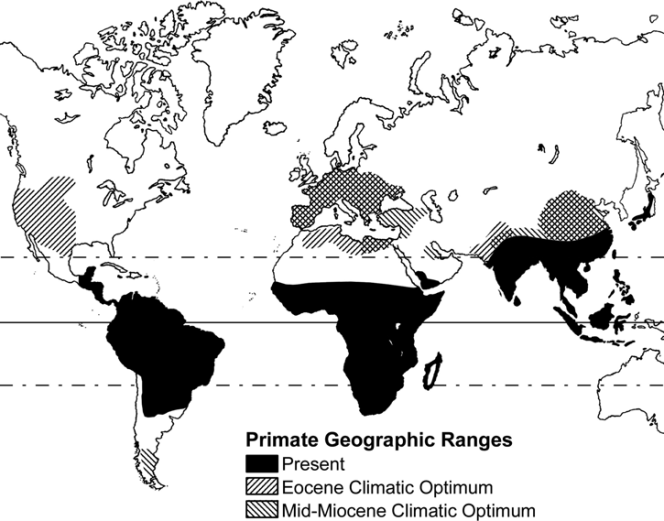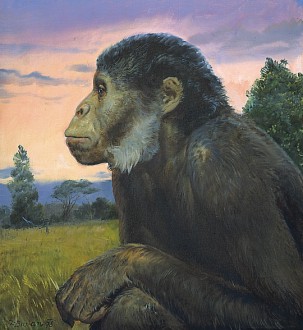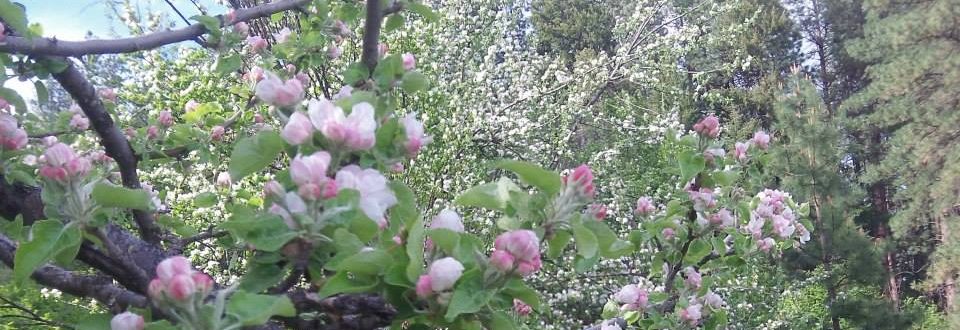What if we saw the food forest from a paleontological perspective? In particular, what if we saw the food forest as the restoration of primate habitat, a habitat which flourished in the Northern Hemisphere, from the end of the Cretaceous and into the Miocene Epoch, if not beyond. What if we used this “Arcto-Tertiary” forest as the model for agroforestry?
Informed by paleontology, I would argue that food forests are not a novel and unprecedented assemblage of genre, but a resurrection of ecologies similar to to those which supported our primate ancestors, for most of the Tertiary.
A paleontological perspective yields the following understandings:
- Today’s temperate tree genera have changed little since the end of the Cretaceous.
- Our lineage underwent relatively rapid change in that same period, beginning as small shrew-like insectivores, and becoming large bipedal predatory omnivores.
- Nonetheless, most of our Tertiary ancestors were arboreal and ate fruit. They used the same plant genera for food for most of their evolution.
- The relationships our ancestors formed with plants are still viable today.
- A significant part of primate evolution occurred in the Northern Hemisphere, in modern Eurasia and North America; in forests with similarities to the northern forests of today.

- Some of the earliest primate and proto-primate fossils come from Paleocene and Eocene North America (Plesiadapis, Teilhardina). North America was then part of the continent Laurasia, incorporating Europe and Asia.

- Europe and Asia were hotbeds of ape evolution, for as long as 8 million years. Great Apes, and the ancestor of chimpanzees, orangutans, gorillas, and humans, may well have originated in Eurasia (Dryopithicus, Rudapithicus).

- Baboon-like, terrestrial Theropithecus monkeys ranged from Spain to India until the late Pliocene. Baboons are a close analogue to humans in their foraging.
- The terrestrial Northern Hemisphere was almost totally forested for most of the Tertiary. Steppe and grassland species became prominent only after the Miocene.
- This circumboreal “Arcto-Tertiary Forest” unified genera today separated into the diminished floras of the North (W. North America, E. North America, Europe, and E. Asia. Douglas firs grew in Europe. Ginkos grew in Oregon. Persimmons grew in Washington).
- The Arcto-Tertiary Forest grew in a climate warmer and wetter than today’s. Temperate conifers grew with evergreen tropical flora. Figs grew in Washington. Metasequoias grew in the Arctic.
- The separation of temperate and tropical forest by deserts and seas, (except in E. Asia) is relatively recent. These forests were once more blended.
- Extant tropical apes use many plant taxa familiar in colder climates, particularly where they forage at high altitude.
- The genus Homo evidences a long history in Eurasia (Dmanisi, Republic of Georgia- 1.8 million years. Shangshazui, NE China, 1.6 million years. Norfolk, Britain, 900 thousand years)


- Although Homo sapiens sapiens is a relatively recent arrival to the Northern Hemisphere (125 thousand years), northern human species such as Neanderthals, Denisovans, and possibly others, live on in our genes.
- Although humans arrived in N. America only 14 or more thousand years ago, much of the continent had a taiga flora almost identical to Eurasia’s at that time. Further south, North America shared the majority of its plant genera with Eurasia, following tens of millions of years of Beringian exchange. Neotropical plant species have been feeding New World primates since 40 million years ago.
- The Homo erectus who lived in NE China 1.6 million years ago, would have found North America familiar and habitable at that time. And the same is perhaps true of Europe’s Miocene apes.
- Denmark and other parts of N. Europe, once freed of glacial ice, were colonized (or-recolonized) by hominids, no sooner than North America.
- The majority of indigenous food plants used in North America have counterparts in the Old World.
- Although humans have developed physical and cultural adaptations for life outside of the forest, we retain the capacity to derive much of our subsistence directly and indirectly from forest ecosystems and perennial plants. Appropriate technology provisions for new uses of forest ecosystems (fuel, fiber, medicine, building materials).
- Our oldest foods are naturally the healthiest for us, and require the least amount of energy and technology to use, and are therefore at the heart of any sustainable culture.
- Taking cue from our primate ancestors may be especially wise in an Epoch of climate change, which will likely take carbon levels and temperatures back to the Eocene of Plesiadapis, and as megafauna continue to go extinct.
- For most edible tree genera, there exist species adapted to each of the principal precipitation regimes (Mediterranean, continental, arid, humid).
- Cold climate species tend to be more widely adapted than tropical species, owing to the need to adapt to seasonal climate extremes.

Europe’s Dryopithecus
From the above points, we may distill something of a thesis:
- Almost any assemblage of tree species modern humans concoct has a natural precedent in the deep past. Such assemblages may better reflect the long term trends of nature better than “native” forests.
- All of the North’s temperate forests may be regarded as ancient primate habitat, and our habitat.
- Thus, the obstacles to sustainable forest subsistence are not horticultural or technological, but psychological/philisophical. Modern native and exotic forests can meet human needs at any technology level, without horticultural intervention.
In the future, I hope to publish a comprehensive reference for northern food trees, their evolution, their paleoecological relationship with our primate ancestors, their paleoethnobotanical evidence, their ecology, their historic ethnobotany, their horticulture, and perhaps also their cultural mythology. In the meantime, I am content to point out the rich paleobotanical sites of my region (Ginkgo Petrified Forest, Stone Rose), the fossil primate evidence at the John Day Fossil Beds and elsewhere in the country, and the much publicized fossil interpretations of the Old World.
I call this paleontological perspective “The Miocene Primate Perspective”, bringing to mind a time when great apes foraged a familiar woodland flora of Europe, and the last time diverse deciduous forest flourished in what is now the dry interior of North America. The Miocene is thus a model for my own food forest endeavors, which I regard as the restoration of primate habitat.
The Miocene Primate Perspective rightly blurs the line between natural forest and food forest. It gives us a natural model to compare our efforts with. And it gives us confidence to make bold ecological actions in the face of climate change. For me, the perspective provides a deep sense of belonging and serenity. Miocene awareness has cosmological implications. We have a niche in nature, and not just in faraway tropical Africa, but also here, now, in the wilds of our backyards. This is as true of overgrown city lots as of pristine wilderness. The living planet is our home.

(illustrations jacked from Google)

